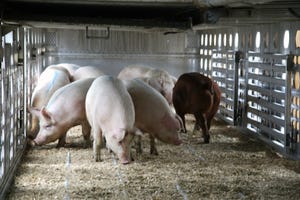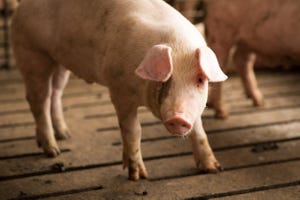Heat no service impact on gilt performance and longevity
Prior to a gilt's first service, if she has one or more heat no service events, performance will supersede those gilts with no heat no service events.
July 5, 2023
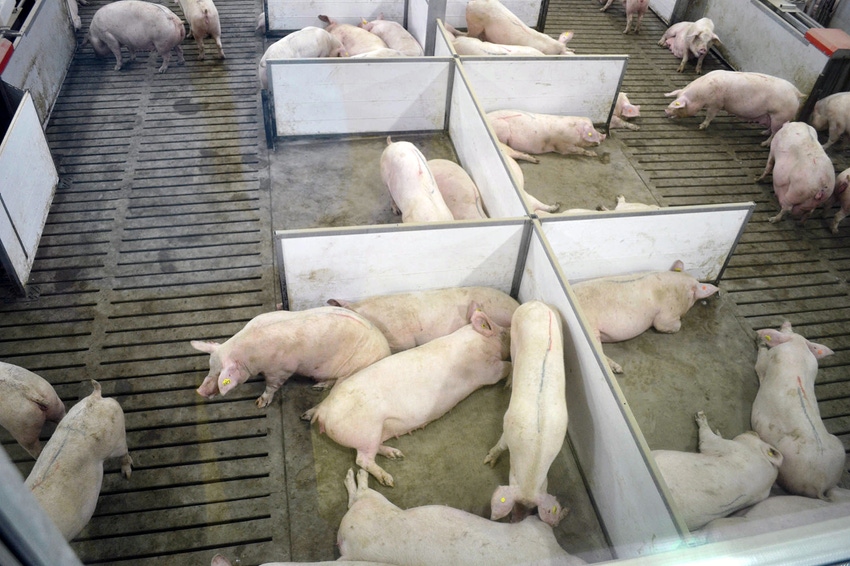
In the last nine years that I have been with MetaFarms, a question that I get asked the most often from sow farm producers is, "Looking at my data, how can I get better?" Aside from the obvious million-pound elephant in the room that is a healthy pig is king, the answer back to the producer is the question, "How is your gilt management?"
Management consultant, educator, and author Peter Drucker was quoted saying, "You can't manage what you can't measure." He went on to say, "Unless you measure something, you don't know if it is getting worse or better." The vast amount of information that each sow farm captures and enters into a record keeping program is mind blowing, such as why and how an animal was removed, which person serviced the animal, what farrowing room the sow entered in to, and much more! Just the opposite can be said with data captured in gilt developer units.
When to tag new arriving gilts?
When your farm receives new gilts into your GDU, the animals are usually isolated from the main herd for six or more weeks. During this time, vaccinations are occurring, treatments are given, heat no service events are being entered, and non-selection animals are removed. The time of arrival into the GDU is the ideal time for when individual identification (tagging) should occur. Many sow farms will wait to individually tag an animal until right before the first service occurs. The amount of short and long-term information that is being missed will cost a farm much more than the cost of a tag and the labor needed to document the different events in the GDUs. Below is a list of events that occur in GDUs along with a summary of how that event can be used for future analysis and animal management:
Heat no service: Prediction for next heat cycle.
Removals: Animals removed in GDUs due to death or structure are costly.
Feed intake: Long-term productivity based on feed intake.
Below is a list of what every new arrival gilt should have recorded as an attribute:
Main ID
Alternative ID (in case the main ID is lost)
Arrival date (Extremely important)
Arrival parity
Origin (Prior site location. Some sources have better quality of gilts than others)
Age or birthdate (Does not need to be the exact date, something is better than nothing)
Genetic line (Extremely important for future performance and retention analysis)
Performance and longevity by number of HNS
Sow farm performance and longevity analysis was performed utilizing the MetaFarms Ag Platform where 10 randomly selected sow farms where chosen based on two main criteria. From these 10 sow farms, data was analyzed for new gilts arrived between January 1, 2021, to December 31, 2022, which consisted of nearly 40,000 gilts.
Characteristics of the 10 sow farms:
U.S. based farms
Midwest located
Generally healthy (porcine reproductive and respiratory syndrome negative or stable)
Conventional production (No batch farms included)
The table below shows the parity 1 performance and removal differences between those animals that had 1, 2 or more heat no services events and those with no HNS events. The farrowing rate difference between those with 2+ HNS events was 4.8% higher than those with none, and 0.47 improvement in total born. 22.2% of those with no HNS events were removed before the first farrow, 17.3% had only one farrow event. The normal financial breakeven for gilts is to get between 2 to 3 parities. Those with no HNS events lost 47.3% before the 3rd parity.

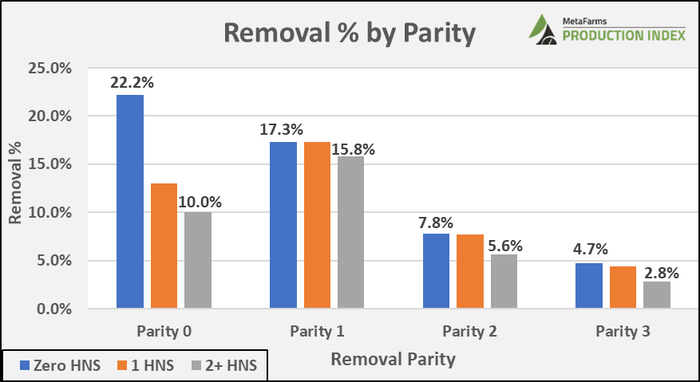
Age at first service
The age at which a gilt is serviced is extremely important to ensure that the animal is sexually mature enough. Servicing of younger gilts means the ovaries can be underdeveloped which will lead to a low volume of eggs, whereas older animals are usually heavier with downsides being poor structure, fertility issues and farrowing complications.
The chart below is a look at farrowing performance by age at first service. In MetaFarms, the age at service is calculated from the first service date minus the age or birthdate from the arrival event. The chart is then further separated between those gilts with no HNS events and those with one or more HNS events. Most animals were bred in the 210–239-day age range among the two HNS criteria. With that age range, those animals with 1+ HNS events had a 7.58% better farrowing rate and 0.3 advantage in total born.
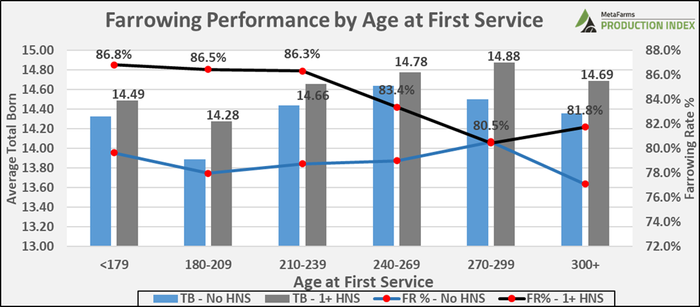


Removal by parity
The chart below looks at the cumulative total born average for those gilts that arrived in 2021 and 2022, by removal parity for a rolled-up removal category reason of reproductive reasons. Reproductive reasons would include animals that were removed due to: no heat, did not conceive, multiple returns, not in pig and preg. check negatives. 38.3% of the animals were removed due to reproductive reasons. The black line is representative of removals with at least one heat no service event. By parity 5, the total born difference between those animals that had at least one HNS event and those that did not was 7.5 pigs.
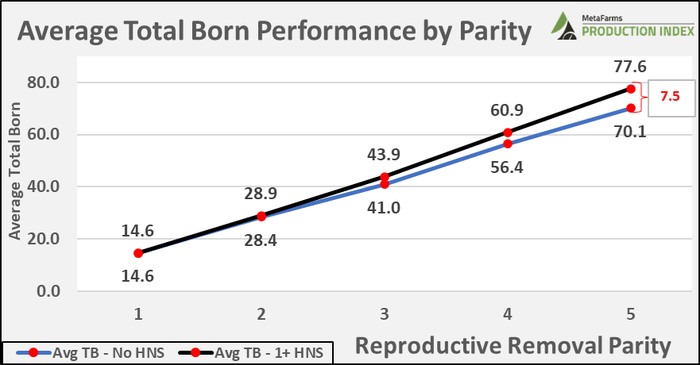
The table below is a compliment to the chart above with the addition of the breakdown of parity removal along with cumulative born alive totals. As a reminder, these removals were reproductive reasons only. Parity 0 are animals were arrived at the sow farm, serviced but did not have a farrow event. 90.0% of reproductive reasons were removed before parity 3. 68.6% were removed prior to parity 3 with those with at least 1 HNS event.

Commitment to success:
A quote from former college football coach Lou Holtz says, "Build your empire on the firm foundation of the fundamentals." That saying is true in all walks of life, including within the pork industry. The long-term success of any farrow to finish operation is dependent on the quality of new arriving gilts. Data within this article clearly shows that prior to a gilt's first service, if she has one or more heat no service events, the early and long-term performance will supersede those gilts with no heat no service events.
It can be easy for farm staff to push aside the daily chores involved with gilt management and with valid but unacceptable reasons. In recent years, mobile applications have become easier to use and more reliable for GDUs. Having a dedicated mobile device at the GDU site will allow the farm staff to enter in the daily events quickly and easily and will limit the spread of any possible diseases by moving the device around to other sites. The MetaFarms platform works for GDU record keeping, allowing the data recorded to follow along with the animal to the sow unit so that no data is lost.
The information collected in GDUs can and will lead to short and long term financial and management practices that can separate the best performing sow units, to those units that struggle to get over the hump. Those top performing farms, with 30 pigs weaned per mated female per year or more, have a solid foundation for their sow farm, whereas those that are struggling, have a leaky foundation with questions of what the cause is. Without the right information, how can you measure it?
MetaFarms Analytic Insights were used to provide the context and trends for this article. If you would like to talk or see an analysis of how the heat no service performance for your farm is, or if you have suggestions on production areas to write articles about, please e-mail or call us. We enjoy being a part of the National Hog Farmer Weekly Preview team. Previous Production Preview columns can be found here.
If you have questions or comments about these columns, or if you have a specific performance measurement that you would like us to write about, please contact Bradley Eckberg via email.
You May Also Like

